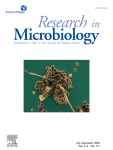Ver ítem
- xmlui.general.dspace_homeCentros e Institutos de InvestigaciónCICVyA. Centro de Investigación en Ciencias Veterinarias y AgronómicasInstituto de BiotecnologíaArtículos científicosxmlui.ArtifactBrowser.ItemViewer.trail
- Inicio
- Centros e Institutos de Investigación
- CICVyA. Centro de Investigación en Ciencias Veterinarias y Agronómicas
- Instituto de Biotecnología
- Artículos científicos
- Ver ítem
Efficient method for targeted gene disruption by homologous recombination in Mycobacterium avium subspecie paratuberculosis
Resumen
Targeted gene disruption by homologous recombination, has been widely used in mycobacterium species to understand the genetic basis of virulence and persistence in the host and to develop efficacious potential live vaccines. However, in slow growing pathogenic mycobacteria as Mycobacterium avium subsp paratuberculosis (MAP), these methods have been inefficient, in part due to the low frequency of legitimate homologous recombination. Another feature of
[ver mas...]
Targeted gene disruption by homologous recombination, has been widely used in mycobacterium species to understand the genetic basis of virulence and persistence in the host and to develop efficacious potential live vaccines. However, in slow growing pathogenic mycobacteria as Mycobacterium avium subsp paratuberculosis (MAP), these methods have been inefficient, in part due to the low frequency of legitimate homologous recombination. Another feature of mycobacteria is the low efficiency of transformation; therefore, some years ago, a phage-mediated transduction process was developed to introduce DNA into mycobacteria. This strategy is very efficient, due to the high rate of infection of the phage. This report describes a genetic method for the generation of targeted deletion mutations in MAP by allelic exchange using in vitro-generated specialized transducing mycobacteriophages, which does not require the critical packaging step and that could also be applied to other mycobacteria. We provide a detailed gene deletion methodology and demonstrate the use of this genetic system by deleting the mce4 operon of MAP. Finally, our results showed that the deletion of mce4 in MAP induces triacylglycerol accumulation; alter morphology and aggregation in liquid culture.
[Cerrar]

Autor
Alonso, Maria Natalia;
Malaga, Wladimir;
Mc Neil, Michael;
Jackson, Mary;
Romano, Maria Isabel;
Guilhot, Christophe;
Santangelo, María De La Paz;
Fuente
Research in Microbiology 171 (5–6) : 203-210 (July–September 2020)
Fecha
2020-09
Editorial
Elsevier
ISSN
0923-2508
Formato
pdf
Tipo de documento
artículo
Palabras Claves
Derechos de acceso
Restringido
 Excepto donde se diga explicitamente, este item se publica bajo la siguiente descripción: Creative Commons Attribution-NonCommercial-ShareAlike 2.5 Unported (CC BY-NC-SA 2.5)
Excepto donde se diga explicitamente, este item se publica bajo la siguiente descripción: Creative Commons Attribution-NonCommercial-ShareAlike 2.5 Unported (CC BY-NC-SA 2.5)

